25-30
December 2001
From
the telescope lens of Stanley Allen whom I met by chance in the shelter
of a Beach Hut, warmed by bright sunshine on the beach behind Widewater
Lagoon.
Large
numbers of Razorbills
have been seen offshore over the Christmas
period,
up to 2500 according to Stanley Allen. He told me that high numbers have
been reported all along the Sussex coast.
Great
Crested Grebe and Red-throated Diver were also seen recently.
Sussex
Ornithological News
29
December 2001
Snow
falls before dawn and a thin layer of snow covers the pavements and from
my window the downs can be seen in the murky distance
covered in a sheet of white. In the afternoon a weak sun melts the snow
in town but a frost-like crust still covers Slonk Hill. The snow virtually
disappeared by the following morning.
Photograph
of the Adur at Shermanbury
Shermanbury
Portfolio (Snow pictures by Allen Pollard)
26
December 2001
A
large number of Dabs, Limanda limanda,
were caught by Jeff,
an angler off Shoreham Harbour Arm, a least 10
over 30 cm long were taken home as large enough to make a decent meal.
This flatfish are caught until February inshore off Sussex. Smaller fish
were also caught.
Sussex
Marine Life
10
December 2001
A
very late and battered Red Admiral Butterfly
settled on a Hebe shrub in my Lancing garden (TQ 185 046).
Butterflies
of Lancing
c.
5 December 2001
Two
deer, probably Roe Deer,
are seen for the first time in Ricardo's Test Field (TQ 201 062) next to
the A27 trunk road and east of the Sussex Pad.
A Peregrine
Falcon is spotted again (first report on these pages) roosting
on Southwick Power Station in Shoreham harbour.

29
November 2001
A
Full Moon is at 8:51 GMT, the second Full Moon in the month is known as
a Blue
Moon.
29
November 2001
A
couple of the large white ducks, with a bright orange band around their
long necks, were Shelducks,
which appeared a large duck when they waddled around much larger than the
convoy of Mallards,
but when on the surface water of Widewater Lagoon
the Shelducks appeared smaller.
14
November 2001
A
Green Woodpecker
is spotted up a Beech tree on Lancing
Ring near the Dewpond.
This attractive bird can be found in country gardens and occasionally in
large town gardens in the Adur district, notably St. Michael's vicarage
in Southwick and at Shermanbury.

30
October 2001
Amongst
the moist grasses of the Adur levels, west of the Waterworks (TQ
209 068), the large white mushrooms with a
long white stalk appear to be Volvariella
speciosa. The appearance of the cap varies in colour from off-white
in the parasol-shaped specimens to a dirtier white almost brown in the
larger specimens which were flat, and in the older-looking specimens the
cap was upturned to form a shallow cup. The underside and gills vary from
a light straw colour the dark brown of a commercial mushroom. The cap of
the largest of seven specimens in a square metre was at least 150 mm in
diameter.
British
Fungi Discussion Forum
10
October 2001
The albino
(white-winged) Magpie has returned to
the area of the old railway line between Old Shoreham and Ropetackle (TQ
211 052). I had seen on a couple of occasions
in the last two years, but the view was from underneath and so fleeting
that by the following day doubts had crept in and I removed the entry from
the Nature Notes page. This time I could see clearly the white upper wings
and the whole bird was whiter than a seagull with just a few black patches.
It also perched briefly before being disturbed by a Magpie with the normal
black wings.
8 October
2001
Another
Grass
Snake slid rapidly away on the gravel path adjacent to the petrol pump
storage area on the east riverbank near Adur Metalworks (TQ 211 052). This
time there was farther for the snake to slide before it reached any sort
of cover and I could see its darker triangular head off the ground, the
first time I had seen this in a Grass Snake. (Earlier
Report Link)
Near
the Waterworks itself, not one but two Roe
Deer jumped out from the undergrowth (TQ
209 068). The dragonflies were absent but
there were small butterflies on the wing. When one settled on a grass,
it was clearly identified as the Small
Copper.
Previous
Deer Report Link
Full
Report of the Day
 3
October 2001
3
October 2001
On
the Adur Levels next to the Steyning Road (TQ
209 068) there were scores (20+) of medium-sized
blue-patterned dragonflies hawking between the reeds and waterside vegetation
by the stream. It was difficult to get close enough to identify these colourful
insects, but my identification of these is the Migrant
Hawker, Aeshna mixta.
Allen
Pollard's Then & Now web pages
British
Dragonfly Society Species Checklist
Freshwater
Life of North-western Europe Smart Group

About
a hundred black
caterpillars covered the leaves of a couple
of low growing Stinging Nettle plants (TQ
209 068). These are the caterpillars
of the Small Tortoiseshell Butterfly.
What
is the Caterpillar web page
UK-LEPS
Discussion Group (for Butterflies and Moths)
29
September 2001
As
I sat in the office gazing through the window, a Grey
Heron settled on
the
rooftop of the bungalow diagonally opposite us. The two Crows
were not
happy
and tried to dislodge it without much effect. The small garden pond
of
Barry the Birdman are probably visible from that roof top. It is short
flight from my Lancing garden to the wide expanses of New Monks Farm and
its drainage ditches.
28
September 2001
On
the footpath from Mill Hill heading due west
immediately south of the road bridge over the by-pass (TQ 208 064), I surprised
a large metre long adult olive-green
Grass Snake curled up and not that quick
to slither into the ivy undergrowth. The nearest streams are 200 metres
away down a very steep incline. This is only the second adult snake I have
ever seen in Shoreham.
Grass
Snake Link
Grass
Snake Photographs (Link)
Full
Downs Report
Estuarine
Bird Report
Late
September 2001
My
Shermanbury garden in the Adur Valley, 14
miles north as the crow flies from Old Shoreham,
was visited by Blue Tits,
Great
Tits,
Greenfinches
and Chaffinches.
On
a countryside walk I spotted an unfamiliar butterfly
with orange wings and black markings which I discovered was a Small
Copper.
Shermanbury
Bug Reports and Photographs
21
September 2001
In
the River Adur north of the Toll Bridge, the surface
was rippled by shoals of young Sand Smelt,
which scattered in many directions and there was a pronounced arrow-like
disruption of the water surface, which probably indicated predation by
a large fish, most likely to be from shoals of second year Bass.
British
Marine Life Study Society
19
September 2001
The
Tide
Chart forecasted a 7 metre tide at Shoreham,
which is about 0.5 metre higher than the highest tides forecasted for the
1970s. The River Adur lapped at the sea walls but
there was no likelihood of a breach. The tide rose to within about 0.5
metre of the highest I have observed in February 1983.

A Little
Egret was feeding in the shallows which
were much nearer the bank than usual and it flew low over the river to
the airfield towpath on the opposite side of the river.
Link
to Egrets at Thorney Island (1999)
Bird
Report (Adur Estuary mid-September 2001)
Adur
Estuary page
Adur
Estuary Survey
All
day the numbers of House Martins
seem to escalate and by early evening, the hundreds turning to over a thousand
in Shoreham and Lancing, and in Shoreham Town Centre, especially around
St.
Mary's Church, they put on a spectacular aerobatic show, swooping low,
all prior to their migration.
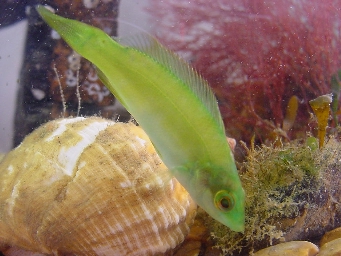 18
September 2001
18
September 2001
There is a considerable
amount of silt on Kingston Beach. The tide went
out a very long way below the Chart Datum
marker, the foot of the Thru'penny Bit (Harbour Control) was exposed, and
the thick mud was nearly dangerous, in most parts the boots would sink
below ankle depth in black smelly mud. The conditions were unsuitable for
prawning. Over winter this mud gets scoured away - it usually arrives as
a result of harbour dredging. In the upper-mid shore pools underneath the
groynes, there was a solitary juvenile Ballan Wrasse
and small prawns.
British
Marine Life Study Society (link to web pages)
 18
September 2001
18
September 2001
The
Information Booth at Widewater Lagoon is officially
opened by Tim Laughton MP (East Worthing & Shoreham). It contains a
picture display and information by Ray
Hamblett and Steve Barker.
Widewater
Lagoon page (by Ray Hamblett)
Lancing
Nature & History - September 2001 Newsletter
17
September 2001
I recorded my first specimen
of the Hairy Hermit Crab, Pagurus
cuanensis, intertidally at Worthing
Pier.
The
distinctive red legs of a returning Redshank
stood
out clearly in the fading light at the low spring tide on the estuarine
mud bank of the River Adur underneath from the Footbridge
crossing the river at Coronation Green, Shoreham.
Usually
I have difficulty in separating Swallows
and House Martins with
hundreds performing aerial acrobatics over Shoreham Beach including Widewater,
where they were particularly common, numbering over several hundreds. However,
today they were flying so low and so close that at times I was able to
look down on them and it is then that their white upper midriff of the
House
Martins become clear.
14
September 2001
A
great of commotion greeted my presence in a private wild field (TQ
209 068) near
Shoreham Waterworks, but I was still surprised when a young
Roe Deer, without antlers, suddenly jumped out of some dead undergrowth
just over a metre high and veered towards me passing just three metres
away before running off rapidly towards the road. It stopped about 30 metres
away and looked over its left shoulder like a doe. A few minutes later
I saw a pair of deer looking like a parent and youngster in the distance
in a field under Mill Hill.
Full
Report
10-11
September 2001
As
the blackberries
are removed from the bramble bushes and the sycamore seed capsules gyrospin
in the wind, the last few butterflies flutter around included a Comma
seen by Jan Hamblett
in their Lancing garden (TQ 185 045)
with two Painted Ladies.
Speckled
Wood Butterflies are still at Shermanbury,
seen by Allen Pollard.
The
Brimstone
Moth,
Opisthograptis luteolata,
that is attracted to lights at this time of the year has caterpillar that
feeds on the Hawthorn.
Butterflies
of Lancing
4 September
2001
The
first signs of autumn are apparent as birds in the Adur valley are on the
move. On an overcast day the obvious example was influx of black and white
birds slightly larger than a sparrow in the hedgerows (TQ
205 073) on the Beeding
cycle path. These were possibly Great
Tits.
Full
Report

31
August 2001
A Wasp
Spider, Argiope
bruennichi, was found on Lancing
Ring (TQ 180 065) by
dog walkers Alex Wilkinson and his mother Vicky. It a large (bigger than
a fifty pence piece) yellow, black and white spider in a big web..."
The
discovery was verified by Dr Gerald Legg at the Booth
Museum of Natural History.
Although
fairly rare, these immigrants are gaining a foothold in Sussex and according
to a spokesman at English Nature found at several locations around the
area including Rye, Heathfield, and Hastings. They are normally to be found
on land surrounding the Mediterranean they have spread northwards. They
have established themselves in southern England since the 1990's.
Wasp
Spider (Orb Spiders Page) Photographs and Information
Spiders
of North-West Europe
29
August 2001
The
first Humming
Bird Hawk-Moth, Macroglossum
stellatarum, of
this year buzzed
around the Buddleia
bushes on the path to the Waterworks Road (TQ
209 063). After the rain shower, there were no butterflies or dragonflies,
only a yellow Brimstone Moth.
The Grey Herons
had left the meadows to feed at the low tide neaps on the River
Adur north of the fly-over. Under the Railway
Viaduct, tiny Common Goby fry, Pomatoschistus
sp., were present in their thousands amongst the small clumps of Irish
Moss, (a seaweed) Chondrus crispus.
These fish would be too small (20 mm) and quick to excite the interest
of even the Black-headed Gulls.
 28
August 2001
28
August 2001
The
small brown dragonfly on
the path to the Waterworks Road at the steps down in the south-west corner(TQ
209 063) was noted because of its dark
green head, and a red fringe on one wing and black on the other pair of
wings. It was probably a Common Darter
Dragonfly, Sympetrum striolatum.
Adur
Dragonflies & Damselflies
A
faded (dull coloured) Small Tortoiseshell
Butterfly settled briefly, as did a Speckled
Wood and a handful of Red
Admirals.
27
August 2001
On
the edge of the arable field (TQ 175 064) next to Halewick
Lane, Lancing, a handful of small brownish butterflies
flit past. I was only able to identify the species as the Small
Heath, Coenonympha pamphilus, after
consulting the reference book. The eyespots and the small size make them
unmistakable.
The
adjoining field is covered in a mass of tall and short wild plants that
have settled in since the topsoil was replaced over the landfill
that once occupied this land. The mix of plants is nothing like that would
normally cover downland, it more resembles colonisation of a derelict building
site.
Earlier
Reports of Small Heath
Butterflies
of Lancing
Butterfly
Guide

August
2001
I
have identified this dragonfly discovered by Allen
Pollard at Shermanbury
as the Southern Hawker,
Aeshna
cyanea. (This could be a Migrant Hawker
?)
Earlier
Report
Shermanbury
Bug Reports and Photographs
British
Dragonfly Society Species Checklist
Dragonflies
of Ireland
23
August 2001
Wheatears,
fly to and from over the shingle beach between Widewater
Lagoon and the sea, their white rear very distinctive, before this
slim bird settles prior to its long migration back to Africa for the winter
months. Three birds were seen by the beach huts. There were probably more.
A
few Red Admiral Butterflies
appeared to flutter in from the seaward side, but these butterflies are
strong flyers and they may be just be moving from one nectareous plant
to another.
Coastal
Shoreham
It
was early evening, (7:30 pm with reasonable light) In Dolphin Road, Shoreham,
(TQ
224 055) a very small (scarcely bigger
than a thrush) bird of prey dived headlong into the bramble bush right
next to me as I cycled past. There was no further commotion as the speckled
breast bird with a grey and brown underwing (strongly banded) rose from
the bush and rested, silhouetted, on the roof of the house on the opposite
side of the road. After a wait of over a minute, it disappeared flying
as straight as an arrow. I think this was a juvenile
Kestrel,
behaving like a Sparrowhawk as they tend
to in the autumn. On 28 August 2001,
a large female Kestrel was
observed leaving a bush adjacent to Widewater Lagoon
before flying away rapidly and then soaring.
20
August 2001
 The
long spring tide went out below Chart Datum
on Kingston beach and there was a meal of large
prawns Paleamon serratus.
The presence of a dozen very small Common Starfish,
Asterias
rubens, was unusual for this particular shore. There was an interesting
mixture of typical fish and invertebrate intertidal life, with hundreds
of very small (30 - 55 mm) first year Bullheads.
The
long spring tide went out below Chart Datum
on Kingston beach and there was a meal of large
prawns Paleamon serratus.
The presence of a dozen very small Common Starfish,
Asterias
rubens, was unusual for this particular shore. There was an interesting
mixture of typical fish and invertebrate intertidal life, with hundreds
of very small (30 - 55 mm) first year Bullheads.
Full
Report
Intertidal
(Seashore)
18
August 2001
Brianne
Reeve led the Butterfly
Conservation Society walk at Lancing Ring.
Full
Report
Friends
of Lancing Ring
 17
August 2001
17
August 2001
As
the Harrier Jump-jet roared overhead, in the meadows amongst the scrub
on Mill Hill, the Common
Blue Butterfly was common (100+) clinging,
wings folded, to the stems of long grasses and wild plants, to rise fluttering
in the late summer evening when disturbed. The females are smaller, brown,
decorated with distinctive orange spots on the upperside. There were a
few Chalkhill Blues as
well, some a bit battered and old, others fresher, as well as the omnipresent
Meadow
Browns, but
also some strongly flying Wall Brown Butterflies.
Blue
Butterflies (Photographs 2001)
UK-LEPS
Discussion Group (for Butterflies and Moths)
Lancing
Ring Photographic Gallery for August
15
August 2001
On
the low River Adur neap tides between Ropetackle and the Toll
Bridge at Old Shoreham, three Little
Egrets (pic)
stalked the shallows feeding in the shallow pools. One of the egrets seemed
much larger than the other two through the binoculars. In what remained
of the mainstream at low tide a couple of Herons
and a Cormorant
took advantage of the low water and the easy opportunities of feeding on
small fish.
14
August 2001
Herring
Gulls and Black-headed
Gulls circled feeding on flying
ants below the white vapour trails crossing
the white fluffy cirrus clouds in the blue sky, on the first fine, if slightly
hazy day, for over a week.
A
Wall
Brown Butterfly fluttered strongly over
my front garden in Corbyn Crescent, Shoreham
(TQ 224 053). On Mill
Hill I recorded what I instantly thought was my first Adonis
Blue Butterfly (TQ
213 077) amongst the tall grasses. The female
Chalkhill Blue (TQ
213 074) that settled nicely, seem to prefer
the shorter Eyebright
grasslands that are cropped short by rabbits.
Full
Report
Blue
Butterflies (Photographs 2000)
Adur
Butterfly Page
9 August
2001
A
pair of Mute
Swans on Widewater
Lagoon were followed by six cygnets,
not cuddly small offspring but large dark coloured first year juvenile
birds.
8 August
2001
Balearic
Shearwaters, Puffinus mauretanicus,
have been seen out to sea from Lancing adjacent to Widewater Lagoon. This
seems to a regular migration route for this sea bird.
 6
August 2001
6
August 2001
A
large nectar-feeding hoverfly
settled on the Buddleia bush
in a garden in West Way, Lancing, (TQ
198 042) that is near the marshy land between
Shoreham
Airport and Lancing. The species was not positively identified and
this is always tricky as there are at least 250 species of hoverfly found
in northern Europe. It was a large species at about 14 mm long. Bill
Irwin identified this species as Volucella
zonaria.
Hoverflies
Comment
Hoverflies
of the UK
Hoverflies
(Syrphidae), tribe Volucellini
Volucella
zonaria
Report
from Bognor
Adur
Hoverflies
5 August
2001
On
an overcast day, a very small garden pond (TQ
219 063) in The Drive, Shoreham-by-Sea, (near
Buckingham Park) was visited by a golden yellow coloured dragonfly with
red unevenly spaced vertical dashes and black lines on the side of its
narrow smooth abdomen. There were black tips to its wings. I have
tentatively identified this insect as the Common
Darter Dragonfly, Sympetrum striolatum.
"It
sounds as though your identification is correct . Both females and tenerals
are golden and therefore the first signs of red suggest that your dragonfly
is a male just starting to colour up to its final orangey-red. The black
tips you refer to are a pigmented section of wing membrane called the Pterostigma,
which is believed to act as a counter-balance to aid wing-twisting and
wing-tip rigidity."
Common
Dragonflies and Damselflies (photographs)
British
Dragonfly Society Species Checklist
 The
small
white moths were still present in the waterside vegetation.
The
small
white moths were still present in the waterside vegetation.
A
single Peacock Butterfly settled
and a handful of Small Whites fluttered
around mostly before settling on the Buddleia
bush and a Gatekeeper
visited other garden plants for nectar.

30
July 2001
The
first Chalkhill
Butterflies are on the wing on Mill
Hill, although they could have hatched out a couple of days before.
A Brimstone
Butterfly, was also feeding in the margins
of downs and scrub.
Full
Report
Hundreds
of Hoverflies,
Episyrphus
balteatus, invade Lancing (TQ 186 045).
With their maroon head a wasp-like abdomen it is easy to understand why
they are christened the Marmalade
Fly.
Similar
large immigrations have been reported from Dorset, especially from Portland
Bill.
"A couple
of hundred came in through our conservatory. Most of them came in through
the patio doors and buzzed against the ceiling, then died due to the heat.
I hoovered up the dead four times during the day and one time actually
counted 53 bodies on a 3 metre length of window cill."
I have
noticed a few hundreds around, but they are usually present and there seem
to be many more this year.
Hoverflies,
Syridae, although they display warning coloration like wasps, are a true
fly, with a single pair of wings, and a proboscis like a butterfly for
feeding on nectar.
27
July 2001
There
was an Evening Argus report of a large jellyfish
off Worthing. The photograph was not clear enough
to be sure of its identity, but the most likely candidate from the
photograph was the harmless Barrel
Jellyfish, although it could have been the the
venomous Lion's Mane Jellyfish.
26
July 2001
On
a scorching hot day, when by the afternoon the temperatures reached 26°C
hundreds of various species of butterflies
were on the wing everywhere.
Report
from Lancing Ring (Link)
Report
from the Waterworks path to Mill Hill
24
July 2001
57
adult Mute Swans
congregated on the River Adur adjacent to Shoreham
Airport on the flood spring tide but no sign of the Little
Egret reported in the Sussex
Ornithological Society News. There was
a dead Mute Swan on the east towpath midway between the A27 Flyover and
the disused cement works, where a small group of five Canada
Geese swam leisurely away, I thought at
first they were going to swim towards me, so they were probably tame.
Gatekeeper
Butterflies were common everywhere and
on the cyclepath north of Botolphs, there were over 100 in the hedgerow
adjacent to the path next to the set-aside land covered in wild plants
(weeds). Many of the Gatekeepers had a double black surround on the underside,
but only one white dot was present on many occasions. Because of the predominance
of orange and their smaller size, there was no possibility of mistaking
these butterflies for Meadow Browns*. Both species of Whites
(100+), Painted Lady
(one), Red Admiral
(20+), Meadow Browns
(12+) were noticed on he Adur flood plain.
(*
The possibility of Small Heath Butterflies was overlooked.)
Adur
Valley Butterflies
22
July 2001
A
gathering of large bats with a wingspan of nearly 30 cm were seen at the
top of McIntyres Field (TQ 185 061),
which is above the Manor Allotments, in Lancing. Martin
Love of the Sussex
Bat Group identified these as the Noctule Bat, Nyctalus noctulaor
less likely a Serotine, Eptesicus serotinus.
Bat
Detector Kits
Report
by Roy & June Bratton
Bats are
seen in Windlesham Gardens, Shoreham.
20
July 2001
A
Painted
Lady Butterfly
landed on the Verbena bonariensis in
my Lancing garden (TQ 186 045). This plant is rich in nectar and particularly
attractive to butterflies.
Butterflies
of Lancing
18
July 2001
The
Sussex branch of the Butterfly
Conservation Society arranged a walk on Mill
Hill in the morning. The long grasses were still soaked from
yesterday's downpour. I did not make the 11:00 am start but I went up there
a couple of hours later and they were no longer around. The blue
butterflies were not out yet. The only insect of note was a solitary
Burnet
Moth south of the car park (TQ
212 072). It quickly flew away, the bright
red most distinguishable. One of the reasons for my identification was
the cocoon photographed at the beginning of July
and shown further down the page. It is probably the 6-spot
Burnet,
Zygaena filipendulae.
Pictures
of the Burnet Moths
There
was a fair selection of butterflies including Small
Skippers.
17
July 2001
It
needed torrential rain and a near gale to dislodge a 95 mm pine cone (pic)
which nearly landed on my head. It came from one of a couple of old pine
trees just south of the western tennis pavilion in Buckingham Park. I have
identified these trees as Monterey Pine, Pinus radiata.
16
July 2001
A
Gatekeeper
Butterfly settled in my wild garden in
Corbyn Crescent, Shoreham (TQ 224 053), opening its wings to reveal the
splendid orange upperside lined with brown. On 21
July 2001 it was joined by others and they
were present every day for the rest of July.
15
July 2001
A
pair of Comma Butterflies
fluttered around and finally settled briefly in my wild garden, without
nettles, in Corbyn Crescent, Shoreham (TQ
224 053). This is my first definite
report of these butterflies on the Nature
Notes web pages. House Martins
flew overhead from Middle Road allotments.
A
handful of small Gatekeeper Butterflies
fluttered around the Blackthorn (Sloe) bushes (TQ
207 055) and other scrub around the towpath
on the eastern of perimeter of Shoreham Airport.
At
the Old Fort (TQ 234 046),
the Common Lizards,
Lacerata
vivipara, with exceptionally mottled markings,
have found new places to hide after the flint wall has been repaired.The
exceptionally speckled markings of the lizard are found in the
European
Wall Lizard, Podarcis muralis.(This
latter species were kept in the back garden of a house in Old Fort Road
and could be escapes. However, lizards were definitely present in the 1960s
on the walls of the Old Fort and this pre-dated the presence of lizards
in the garden of a herpetologist.)
Postscript:
these lizards have now been definitely identified as the Wall
Lizard, Podarcis
muralis.
Local
Lizard Comparison Photographs
Lizard
Update 2004
Earlier
Report of the Flint Wall Repairs
13
July 2001
Butterflies
between the bridleway (TQ 228 067)
skirting Slonk Hill Farm and Mossy Bottom Barn included Small
Tortoiseshells, Red
Admirals and at least one Painted
Lady (TQ 225 074),
all species eventually settling on the chalk path, and all the butterflies
were in perfect colourful condition.
The
skies around New Erringham Farm were filled with the low flying aerobatic
displays of House Martins
and Swallows,
perhaps Swifts
as well.
12
July 2001
Dragonflies
About
a dozen of the stout-bodied dragonflies flew rapidly over the Lancing
Ring dewpond
(see the previous report). They flew much
too quickly to ascertain any of the smaller details which is necessary
to confirm identification. Both males and females chased each other in
the breeze. However, a brown female dragonfly settled for about two seconds
a couple of metres away and there was just time to spot at least
three large spots of bright orange on one side of the darker brown abdomen.
This together with the brown bulky nature of the flattish abdomen, made
to look more bulky by the brown on the base of the wings makes me identify
this spectacular insect as the Broad-bodied
Chaser, Libellula
depressa. The appearance of bright
green Emperor Dragonfly,
female, was comparatively dull and inactive. A Blue-tailed
Damselfly tried to hide its then abdomen
along a thin waterside reed.
British
Dragonfly Society Species Checklist
11
July 2001
All
boats remain in harbour as the beach shingle is rolled about by the Fresh
Breeze (Force 5 +)
without rain, with many white horses. The shingle
that had been levelled with the renovation to the Inner West Arm of Shoreham
Harbour sea defences south of Soldier's Point, near the Old Fort, last
year, had now been reformed by the wind and returned to its former undulations,
with the return of the common shingle plants including Sea
Kale, Sea Beet, Yellow-horned
Poppy, Sea
Campion, Spear-leaved Orache and the common
weed of wild places, the Sow Thistle
was abundant.
Beaufort
Scale (sea)
9 July
2001
The
remains of two large mature Adders were found
trapped in garden netting in Lancing Manor Allotments.
Just before
dusk Martin Davies cycles into a swarm of aggressive beetles coming out
of a bush near Mill Hill. These could have been
the Devil's Coach Horse Beetle,
Staphylinus
olens, which Ray
Hamblett has reported from the downs above Shoreham. This beetle has
jaws that can pierce human skin and can also squirt out noxious and irritating
chemicals from its rear end.
7
July 2001
The
promised torrential rain arrives at about 5:00 pm with grumblings of thunder.
Although it seemed no more than a prolonged heavy shower, a figure of 34
mm was recorded in 3 hours, according to BBC 1 Southern News. I was able
to verify this reading exactly using the bucket method. .
5 July
2001
Butterflies
On
the long mostly straight steadily uphill path from Southwick
Hill to Truleigh Hill, Small Tortoiseshell
Butterflies were
common (75 +) (this total possibly included some strong-flying Painted
Ladies and Commas),
but there were also Meadow Browns (30+),
Marbled Whites, (25+), Small
Skippers (20+)
Red Admirals (12+) and an occasional Small
White Butterfly in decreasing order of
prevalency.
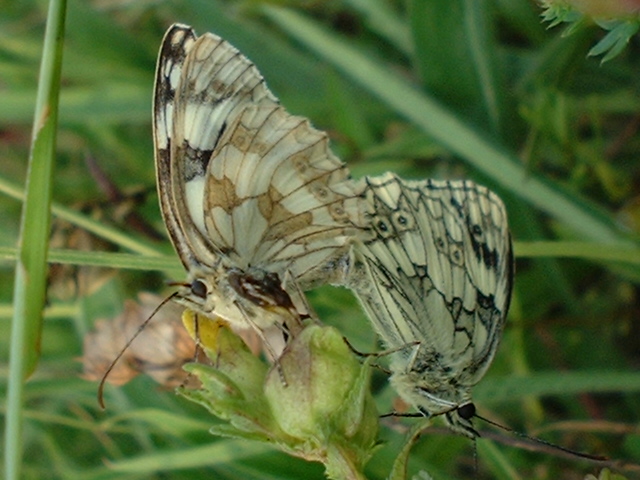
Marbled
White Butterflies
In
contrast on Mill Hill, where nettles on the
downs are uncommon and the meadows unspoiled, the Meadow
Browns (40 +) were the commonest butterfly
in the open but where the grass became longer they were replaced by Marbled
Whites (40+) feeding on Greater
Knapweed, and in the scrub, a handful
of Gatekeeper Butterflies
could be easily separated from the Meadow Browns by their smaller size
and double eye-spot on the underside. They remained settled for long periods
with the wings folded. At first the double eye-spots could be seen, but
after awhile the fawnish bit covered up the orange and the eye-spot. Large
Skipper Butterflies* were a bit battered
but like the Gatekeeper stayed still,
but with their wings open. Red Admirals
flew energetically in the small copse.
(*
could be Small or Essex Skippers.)
Field
Scabious and Pyramid
Orchids were in flower.
Adur
Valley Butterflies (Link)
Shoreham
seems to have missed the thunder and electrical storms in other parts of
the south coast (notably Dorset), but it is exceptionally and uncomfortably
muggy (wet and humid with warm showers). Just before dawn the gulls, Herring
Gulls are squawking a lot just like they
do throughout the day in nearby Hove (but see the note
for 2002).
Lesser
Black-backed and yellow-legged Gulls (Link for more information)
BMLSS
Sea Birds
Sea
Birds Portfolio (Photographs by Nicolas Jouault)
UK
Birding Discussion Forum
Sussex
Ornithological Society News
July
2001
The
crew of the Sussex Sea Fisheries
Protection vessel "Watchful" spot a Bottle-nosed
Dolphin, Tursiops truncatus, in the approaches to Shoreham harbour.
Sussex
Dolphins
 4
July 2001
4
July 2001
Over
a hundred Marbled
White Butterflies were
in the Hay Meadow west of Pat Barton's
Wood (the Little Clump) around Lancing
Ring fluttering in the long grass amongst a cacophony
of grasshoppers and crickets.
The
grasses supported a cocoon from one of the burnet moths.
Full
Species List
Butterflies
of Lancing
Lancing
Nature & History - July 2001 Newsletter
Lancing
Ring Photographic Gallery for July
A
Great Spotted Woodpecker was spotted on
the Coombes road between Cuckoo's Corner and the Ladywell Stream, in a
tree at the bottom of the private path leading to Lancing College (TQ
200 069).
I only
saw one Marbled
White Butterfly in
the long grasses. Meadow Brown Butterflies
(pic)
were common everywhere, near allotments
in the towns, on Lancing Ring and on the Adur flood
plain. Most specimens had a clear pale ring around the eye-spot on
the underside of the wings (pic),
and a single very small black spot as well on the fawn bit. They were very
darkly pigmented brown on the upperside wings. A
Large Skipper Butterfly settled at the
top of the path from the Sussex Pad to Lancing Ring, and there were
a few Small (or Essex) Skippers that
were more restless.
Adur
Valley Butterflies (Link)
Butterfly
Conservation Society
An
Emperor Dragonfly
patrolled the Lancing Ring dewpond
(TQ 181 065), but this was to be expected. However, there was also a much
sturdier-looking dragonfly darting between the reeds. This species is most
likely to be a male Broad-bodied Chaser, Libellula
depressa. The abdomen was a
very pale blue, almost white, and stubby rather than elongate. I
do not think it was a male Black-tailed Skimmer, Orthetrum
cancellatum.
UK
Dragonflies Discussion Group
British
Dragonfly Society Species Checklist
Freshwater
Life of North-western Europe EForum
2-4
July 2001
Hot
and humid at at least 25° C at maximum.

30
June 2001
Sea
Watch Foundation Cetacean Workshop
Lancing
Manor Leisure Centre
Run
by Steve Savage (Regional
Co-ordinator)
This
is the first of three workshops (the second one is on 7
July 2001) on the identifications of cetaceans,
i.e.. whales and dolphins, including these sea mammals seen off the Sussex
coast.
This
first session will provide background to the work of Sea Watch and an introduction
to our work locally and how people can get involved.
Contact
via Adur DC is Natalie
Brahma-Pearl (Tel: 01273 263347)
Sea
Watch Foundation
Sussex
Dolphins web page
BMLSS
Cetaceans
28
June 2001
Shoreham
Beach Nature Reserve
There
will be meeting to discuss the future of the vegetated
shingle at Shoreham Beach, with experts from
English Nature, Adur District Council and West Sussex County Council. The
question of Nature Reserve status will be discussed.
The
meeting is at the Church of the Good Shepherd Hall and starts at
7:00 pm.
The idea
of the Shoreham Beach Nature Reserve received a mixed reception,
with the majority in support, many undecided and a few objectors.
27
June 2001
There
were two calling male
Quail heard from the path from Thundersbarrow
Hill (north of Southwick Hill) to Five Ways
last night, at around 9:30. There was also a possible calling female to
the north west of Lancing College on the same evening.
There
were no Quail calling late in the evening at Steepdown, north-west of Lancing
Clump (on the path to Cissbury Ring), but this is possibly an encouraging
sign of breeding as at least one male had been calling in the area for
two weeks.
Sussex
Ornithological Society Report
Report
by Dave Green
26 June
2001
The
scores of butterflies on Mill
Hill were Small
Heath Butterflies (pic)
and/or Meadow Browns
(pic).
These two species were flying strongly amongst the longer grasses
and I found it difficult to be 100% sure of their identification. They
always settled with their wings closed and at least one did not appear
to have a pair of eye-spots on the light brown upperside of their wings.
The Meadow Brownis
a much larger butterfly than the Small Heath,
so I think most of them were Meadow Browns,
although
I find size hard to judge with strong-flying insects.
It
was an exceptionally hot day for June, with a temperature of 27.9°
C recorded on Shoreham beach.
Shoreham
Beach Weather History 2000 et. seq.
The
first Greater Knapweed
begin to flower. (pic).
Butterflies
(Bioimages)
25
June 2001
Clean
Air Talk by Adur District Council (Tim Bartlett & Natalie Brahma-Pearl)
at the Tarmount Studios 7:00 pm
Messages
on Adur Air Quality
Pyramidal
Orchids could be seen on the Old
Shoreham to Beeding cycleway, but only an occasional Red
Admiral butterfly and not much to see in the heat at 24°
C. The towpath on the west side was overgrown and nearly impassable by
bicycle.
24
June 2001
A
very small garden pond (TQ 219 063)
in The Drive, Shoreham-by-Sea, (near Buckingham Park) was visited by a
male Blue-tailed Damselfly
(the male identified by its blue head and thorax), Ischnura
elegans, and a small white moth,
possibly a common species, fluttered
amongst the waterside plants. Froglets
crawled over the lily pads, where one
lily was in flower, but most of the frog tadpoles
were
still black with only one pair of rear legs in many cases. The tadpoles
develop much more slowly in crowded garden ponds and many fail to develop
at all before the winter.
21
June 2001
The
weather remained sunny if not particularly warm at 22° C for the Summer
Solstice, and at night Mars
shined brightly to the south before midnight, and looked silver-pinkish
through the binoculars in the clear Moonless sky. No detail could be seen
in low-powered 10 x 25 binoculars.
18
June 2001
A small shoal of juvenile
first year Pollack, Pollachius pollachius,
came as a great surprise to me on a mussel collecting
expedition at Kingston beach. In well over a
thousand observations I have never seen shoals of these fry before. The
mid-water shoals are usually Sand Smelt Atherina presbyter; Bass,
Dicentrarchus
labrax; or Grey Mullet, Chelon labrosus. Pollack shoals are
are a characteristic of Cornish and Devon estuaries. At first the back
of the tiny fish up to 40 mm long looked a coppery colour so I suspected
a Pouting,
Trisopterus
luscus, but even in the postlarvae the more streamlined nature of the
Pollack was clear, but if any doubt was needed the marked gaps between
the three dorsal fins was decisive. The fish also lacked the barbel of
the Pouting. Out of sunlight the back looks more greenish-brown. The shoal
numbered about 200, maybe more, as my view was obscured. Thousands of Sea
Gooseberries shared the same sea as the juvenile Pollack.
Dogwhelks,
Nucella
lapillus, have just returned to this shore after an absence from 1982.
They are all old specimens and even 20 years I do not recall any eggs.
With a covering of mud, one Dogwhelk could be mistaken for a Common Whelk,
Buccinum
undatum, especially as its size at 52 mm is bigger than average. Dogwhelks
usually average about 20 mm to 30 mm, and specimens can reach 60 mm. On
Kingston
beach, they still need looking for, and are rarely below 35 mm in length.
The woolly caterpillar of
the Garden Tiger Moth, Arctia caja,
crawled over the tarpaulin in the basket of my Pashley delivery bicycle
in the front garden of my home in Corbyn Crescent, east of central Shoreham.
17
June 2001
Over
McIntyres field near Lancing Ring,
House
Martins, Swallows and Swifts
dissect the air with precision flying as they collect airborne food
on the wing. Over farm buildings at Sompting and at the nearby Open Space
near St Mary's Close all three species were seen in spectacular form as
they darted around buildings and over hedgerows. (TQ 156 052)
16 June
2001
A black
wild Rabbit was reported the population
of bunnies at Lancing Down, Sussex (TQ 180 062). This is not thought to
be an escaped domestic rabbit, but a colour strain present in the wild
population and reported occasionally from all parts of Britain.
Report
by Veronica Eltringham (FOLR)
14 June
2001
The
shingle
beach at Shoreham beach along to the Widewater
is a colourful sight with Red Valerian
(red and white) , Viper's Bugloss
(blue), Sea Thrift (pink),
Sea
Kale (white), Tree
Mallow (crimson, not so much as usual),
Yellow-horned
Poppy,
Silver
Ragwort and a few garden flowers particularly
colourful as expected during the best month of June. A party of school
children, pencils and pads in their hand were on a field trip near the
Church of the Good Shepherd.
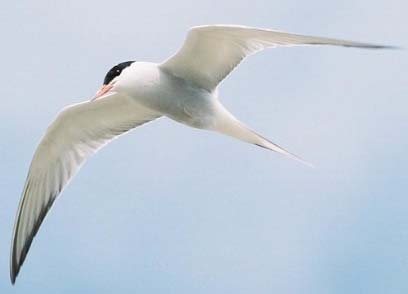 11
June 2001
11
June 2001
Offshore
from Brooklands Boating Lake, Common Terns,
with their distinctive forked tails, swept low over the sea that was showing
the first signs of white horses, and descended to take a feed from just
below the surface in one swift swoop. Black-headed Gulls, in breeding
livery with a completely dark (brown) head, were attempting the same manoeuvre
without the same elegance. A half dozen Cormorants congregated around
the post marking the outlet pipe, occasionally diving under. This is a
regular flocking area for these fish eating birds with frequently up to
29 birds that can be quickly counted.
Sea
Birds Portfolio (Photographs by Nicolas Jouault)
The
Ringed
Plover reveals itself by its swift running
over the shingle. Without moving it is too well camouflaged and difficult
to spot. The summer residents birds and much plumper than the lean winter
visitors. As the tide ebbs and the water recedes,
more (a half dozen in 50 metres of sand) of these small birds appear on
the emerging sand flats.
 Under
the sea, Paul Parsons returned from a brief foray with a handful of very
small Actinothoe
sea anemones, a small sea hare Elysia
viridis, and some other very small
orange anemones with whitish orange tentacles. After close study I can
confirm that these are the often overlooked Diadumene
cincta. The mouth is orange in some specimens, but the most
useful diagnostic difference from the similar Plumose
Anemones is their instant jerky reaction when touched.
Under
the sea, Paul Parsons returned from a brief foray with a handful of very
small Actinothoe
sea anemones, a small sea hare Elysia
viridis, and some other very small
orange anemones with whitish orange tentacles. After close study I can
confirm that these are the often overlooked Diadumene
cincta. The mouth is orange in some specimens, but the most
useful diagnostic difference from the similar Plumose
Anemones is their instant jerky reaction when touched.
Under
Worthing Pier (Page 3)
Sea
Anemones (Link)
 10
June 2001
10
June 2001
Thousands
of Common Spotted Orchids are
in flower on the chalk bank of westbound A27 Shoreham bypass near Slonk
Hill (TQ 225 065).
A
Quail
was calling to the East of Steep Down, behind Lancing.
The
bird can be heard calling from the bridleway which runs from Lancing
Clump to the Bostal Road, and passes to the east of Steep Down. There
is no chance of seeing the bird here as it is on private land 30 metres
below the path, but it was calling at 5:00 for at least 30 minutes around
250 metres to the south of the pylons. This area is also very good for
Skylark,
Meadow Pipit, Corn Bunting, Yellowhammer, Linnet etc.
Sussex
Ornithological Society Report
Report
by Dave Green
5 June
2001
I
made a brief visit to the Waterworks Road. There was nothing much there
apart from the millions of stinging nettles. But I was surprised to see
a Moorhen in the narrow stream, surprised because of the vicinity
of the Vixen and her cubs (see
below).
On
a sunny Mill Hill, above the 45° Sycamore
incline from the Waterworks, butterflies
fluttered around, rarely remaining still for more than a brief few seconds,
because the largest and commonest (12 +) were the restless Wall Browns,
and either a single solitary Small Heath Butterfly or a Meadow
Brown, the single eye spot clearly distinct on the underside from the
orange. There were small orange butterflies fluttered in the grasses and
these could be Skippers. A female Common Blue settled. Lastly,
a single a Dingy Skipper was definitely identified, although the
the white dotted band on the topside of the front wings were much more
distinct than shown in my book.
Butterflies
(Bioimages)

Prawns
This
is rather an ordinary observation but the two species of prawns
found on Kingston Beach are showing remarkable
differences. The smaller Palaemon elegans in the higher pools have
dark blue, almost black, markings and egg masses, whilst the larger Paleamon
serratus at the low tide mark are remarkably reddish with orange egg
masses. This colour guide cannot be relied upon as the larger prawns can
be blue and both species almost transparent with hardly any clear lines.
Both species of prawns had been eating green algae.
7 June
2001

An
Animal
Rights letter was sent to the Shoreham Herald complaining about the
Lobsters in the tubs at Adur World Oceans Day.
Reply
(Link)
5 June
2001
Many
birds in song on the downs approaching Southwick
Hill from the north or west, including Corn
Buntings (15), Yellowhammers,
Skylarks,
and nearer the hill Meadow Pipit and
Whitethroat (10).
Sussex
Ornithological Society Report
Report
by Dave Green
| 4
June 2001 to 15 June 2001 weekdays
|
3 June
2001
A
Fox,
a vixen with three cubs was
seen from a distance of 200 metres on the Waterworks Road, on the flood
plain below Mill Hill. Footpaths lead down
to this private road from the top of the Street in Old Shoreham and from
the bridge over the flyover leading to Mill Hill, but these paths are narrow
and overgrown.
Walking
on wooded land close to the base of Mill Hill
near the River Adur, we saw what appeared to be
a large black to iridescent dark blue butterfly.
It seemed to be larger than a Painted Lady for example. It flew in
a slow fluttering movement and was about 60 cm (2 ft) from the ground as
we saw it. I could not follow its path. A local resident confirmed that
it had been seen previously.
Experienced
lepidopterists have pointed out that it is most likely to be a Beautiful Demoiselle,
Calopteryx
virgo, a damselfly. The Sussex
branch of the Butterfly
Conservation Society confirmed that Beautiful
Demoiselle damselflies had been confirmed breeding on the bird reserve
near the Waterworks on the Adur flood plain, just north of Old Shoreham.
UK
Dragonflies Discussion Group
Lancing
Nature & History - June 2001 Newsletter
Adur
Flood Plain report of the Demoiselle with photograph
2
June 2001
A
pair of Mute Swans with six furry cygnets greeted the workers
setting up at the stalls for Adur World Oceans Day, but as the neap
tide ebbed they had disappeared before the start of the event.
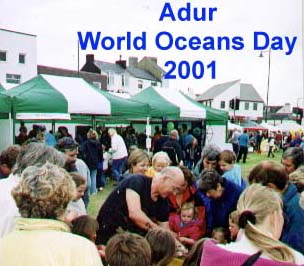
The
day was overcast with brief periods of sun through gaps in the clouds and
short periods of torrential rain that sent people diving for cover in the
marquee. |
29
May 2001
A
Speckled
Wood Butterfly
landed in my Lancing garden (TQ 186 045).
29
May 2001
A
pair of Mute Swans with five furry cygnets were in Shoreham
Harbour, in the canal section east of the lock gates, together with
thousands of Moon Jellyfish.
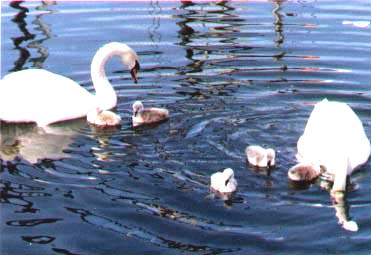
26
May 2001
The
Fox
that
lives around the large beach houses near Old Fort, Shoreham
Beach has the mange. Apparently this can be treated with drugged food
and a kit is provided by Fox Watch.
Report
by David Wood
Previous
Report
25
May 2001
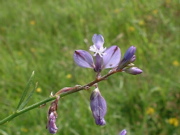 Mill
Hill was covered by vast expanses of yellow on the green grasses,
of Buttercups and
Bird's Foot Trefoil,
with Daises and
patches of blue with the Common Milkwort and
Speedwell,
Veronica
sp., as well as small plants.
Mill
Hill was covered by vast expanses of yellow on the green grasses,
of Buttercups and
Bird's Foot Trefoil,
with Daises and
patches of blue with the Common Milkwort and
Speedwell,
Veronica
sp., as well as small plants.
Butterflies
A
few restless brown butterflies danced in
the light breeze. At least some of the larger ones were Wall
Browns, distinctive because of the black-ringed white eye-spot on the
opened highly patterned wings (different from a Tortoiseshell). There were
smaller brownish butterflies, they were restless and are the Small
Heath Butterfly (TQ 212 071). These butterflies
are easy to misidentify when the similar but larger Meadow Browns are around.
The food plant of the caterpillars of the Small Heath are various grasses.
Meadow
Brown Butterflies have not reported from elsewhere
this early in 2001. They do not appear until mid-June. Notes.
The Grizzled
Skipper Butterfly was exceptionally attractive
when it landed on a buttercup (TQ 212 072).
In
Shoreham
town especially near the allotments and
Sea Kale
on the beach, scores of Small ? White Butterflies
fluttered as expected. About 10% of these had a yellowy tinge.
UK-LEPS
Discussion Group (for Butterflies and Moths)
UK-Botany
Discussion Group
Adur
Valley Butterflies
UK
Wildlife Discussion Group
Shoreham
Beach
Butterfly
Conservation Society
Butterfly
Guide
24
May 2001
A
large (slightly larger than a goose egg) greenish speckled egg rolled down
Ham Road outside the Morning Star Public House. I suspect that this was
broken egg belonged to one of two pairs of Herring
Gulls reported as trying to breed on the
the large flat roof of the nearby Adur Civic Centre.
Report
by Andy Horton with the breeding information from
Tim
UK
Birding Discussion Forum
24
May 2001
The
sea
off Sussex and probably all along the eastern English Channel is exceptionally
clouded with plankton forming long strings in places. This is the species
Phaeocystis
pouchetti known colloquially as
Slobweed and other names.
British
Marine Life Study Society News 2001
23
May 2001
A
particularly beautiful damselfly
caught my eye as it settled on Southwick beach promenade wall next to the
timber yard. It had a particularly brilliant metallic emerald green head
and thorax and an elegant metallic light blue abdomen. There did not seem
to be any distinctive markings on the delicate wings. It may be a female
Ischnura
elegans known as the Blue-tailed
Damselfly. However this identification
is not confirmed.
UK
Dragonflies Discussion Group
21
May 2001
The
ctenophore (comb-jelly) Sea Gooseberry,
Pleuribrachia
pileus, is both ubiquitous and superabundant pelagically in the NE
Atlantic Ocean, but on the low springs (0.4 metre) at Kingston
beach in the early evening was only the second time that I have actually
discovered this animal that appears as transparent globules in the prawn
net. In a miniature aquarium, the two long
tentacles tangle underneath and the swimming combs of this tiny ovoid predator
appear to shimmer. At night it is phosphorescent.
Marine
Wildlife of the North-east Atlantic Ocean Group
20
May 2001
For
my first sighting this year of Orange Tip
Butterfly but had to go to Sussex
Wildlife Trust HQ at Woods Mill, Small Dole, Sussex.
18
May 2001
Taking
advantage of the newly re-opened cycleway
from Old Shoreham to Beeding, the adjacent towpath was covered in a fine
mat of grass. A Kingfisher
flew straight as a dart with something large and white in its beak, and
a Peacock Butterfly settled
on the grasses, notable as my personal first note of this butterfly
on these notes. Other butterflies
fluttered amongst the nettles.
In
the field opposite the Cement Works, on the western side of the Adur
including the towpath, both cows
and sheep grazed.
18
May 2001
The
footpaths to Lancing Ring
are now open.
West
Sussex County Council announce most paths are now open, unless they are
inhabited or used by farm livestock, or farm animals are nearby. At first
it would seem that virtually every single path north of Shoreham
is adjacent to fields that will contain livestock at least at some time
during the year, both on the Downs or in the Adur
Valley, and the restrictions may still apply.
The
cycle
path from Old Shoreham to Bramber has
already started to be used.
|
Most Public Paths
NOW OPEN
Unless a path displays this notice (red with white writing):
|
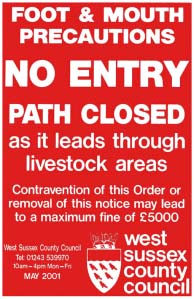
|
You
are welcome to use any public path if you:
Stay
on the path and leave gates exactly as you find them.
Respect
red "no entry" notices.
Donít
go near sheep, cows, goats, pigs, or deer.
Donít
go into any field if you canít easily avoid those animals. |
|
If
you do come across them walk slowly away, retracing your steps if necessary.
Donít
leave waste food or litter anywhere and donít feed ANY animal.
Keep
dogs on short leads at all times and off all land where livestock are present.
Use
disinfectant where provided.
Clean
your boots after each walk. |
|
17
May 2001
It
appears this year there has been an increase in the numbers of Chaffinches,
Robins
and
Song
Thrushes at the expense of Starlings,
which are still abundant. A Great Tit
in St. Mary's churchyard, Shoreham,  was
seen in the strong breezy (Force 6)
afternoon. This bird is reported to be one of the commonest garden birds
in Cornwall, but I have never found it to be particularly common In Shoreham.
was
seen in the strong breezy (Force 6)
afternoon. This bird is reported to be one of the commonest garden birds
in Cornwall, but I have never found it to be particularly common In Shoreham.
Beaufort
Scale (sea)
Beaufort
Scale (land)
16
May 2001
A
juvenile Owl was found on the ground close to the nursery in Lancing
Manor Park. It was picked up and put back in a nearby tree by the Adur
Watch patrol.
Report
by Tim Clarke
15 May
2001
 It
is astonishing the rapidity the Dogwhelks
(a gastropod mollusc)
have colonised the relatively new rock sea defences on Southwick beach
(TQ
240 046) near the lock gates. Hundreds in
mostly white and dirty grey colours, but orange ones and purple ones also,
but there were no signs of striped specimens.
It
is astonishing the rapidity the Dogwhelks
(a gastropod mollusc)
have colonised the relatively new rock sea defences on Southwick beach
(TQ
240 046) near the lock gates. Hundreds in
mostly white and dirty grey colours, but orange ones and purple ones also,
but there were no signs of striped specimens.
Most
of the Beadlet Anemones were reddish-brown
and I saw none of the 'strawberry' variety.
13
May 2001
A
Pond
Skater flew into a garden in The Drive, Shoreham (TQ
219 063). It was walking on the surface of
the small pond, hardly, a remarkable event, and it was probably the commonest
species Gerris lacustris.
Hemiptera
Checklist
UK
True Bugs Discussion Group
11
May 2001
Lancing
Manor allotments hosted two Linnets,
both birds with the distinctive red throat of the male. Under a tin sheet
there were two Grass
Snakes and four Slow
Worms.
A
quick look at St
James' churchyard, Lancing, saw Speckled
Wood, Peacock
and Holly Blue butterflies.
At home in Lancing a Comma
basked on a warm wall briefly.
Butterflies
of Lancing
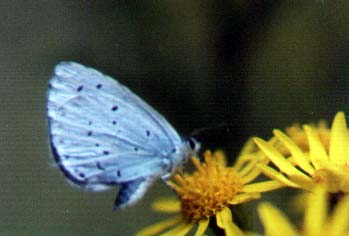 11
May 2001
11
May 2001
Hot
and humid briefly, up to 21° C with the first butterflies
on the wing in Shoreham, including a Small
White Butterfly near the footbridge and
a Holly Blue Butterfly
fluttered rapidly across the Eastern Avenue railway crossing gates and
another one fluttered in the Community Centre grounds in Pond Road, Shoreham.
9 May
2001
A
pair of House
Martins are nesting in Gordon Road, Shoreham-by-Sea
as they did last year.
Two
relatively fine but windy days come to an abrupt end with a thunderstorm
with continuous flashes of lightning and some very heavy rain in the late
evening up to and past midnight. The claps of thunder were loud enough
to prevent any chance of sleep.
8 May
2001
I
saw my first red butterfly
(species unidentified) of the year over the shingle on the sea side of
Widewater, but attention was simultaneously distracted by a female
Kestrel overhead, from underneath the
pale blue with streaks stood out from the blue sky of the first fine and
sunny day of the year. The female looks much larger than a male and could
be mistaken for a Sparrowhawk. This bird glided and than paused for the
familiar hover, before swooping off on the wind. It is usually the
male that is blue underneath.
There
was a meeting between the Environmental Agency, with contractors, Halcrow,
and the Friends of Widewater Lagoon over the sea defences planned for the
shingle between the lagoon and the sea, and the ecological impact on Widewater.
The transcript is on the following site (click on the text):
FOWL
7 May
2001
Foot
& Mouth Restrictions still in force in the Adur Valley
Footpaths
in the lower Adur Valley are still all closed. As far as I am aware, not
a single path has been reopened In West Sussex, so the downs
and Adur Valley are still a no go area for the May Bank Holiday Monday.
1 May
2001
For
summer is a comin' in
And
winter is a gone - o.
A
merry May to you.
The
first day of May was greeted by a cold east wind and continuous heavy rain.

27
April 2001
The
first Moon Jellyfish appear
in Shoreham harbour.
26
April 2001
A Holly
Blue Butterfly
flutters quickly across a Lancing garden. (TQ 185 046).
23
April 2001
The
elongate small fish known as the Butterfish,
because of its slippery nature, or Gunnel (misspelling of gunwhale), Pholis
gunnellus, were present on Kingston beach
on the low spring tide.
22
April 2001
A
count of 340 Bar-tailed Godwits and 81 Gannets plus other
birds flew past Southwick beach.

15
April 2001
I
received a report via the RSPCA of three young sharks washed up on the
beach at either Lancing or Worthing. A size was not mentioned. I assume
these are Lesser-spotted Dogfish, Scyliorhinus
canicula, which are so commonly washed ashore dead in all months of
the year that they scarcely warrant a special mention. The specimen above
was discovered intact near the Old Fort a couple of months ago, before
it had been spotted by the gulls that scavenge along the strandline.
9 April
2001
Ray
Hamblett
reports Common
Lizards, Lacerata
vivipara, (possibly
Wall Lizards?) and
Slow
Worms,
Anguis
fragilis, near the remounts of flint walls
and grassland near Widewater.
Widewater is a brackish lagoon, but there are pools that are probably near
fresh water and dry out in the summer months. These small amphibians and
reptiles occasionally become the prey of visiting Kestrels.
Photographs
(Link to web page)
3 April
2001
A
pleasant sunny day with Meadow
Pipits seen from the river towpath by
the airport, with a splash of white on the underside
of their tail and calling as they leave their perches, including the Sea
Purslane at low tide on the Adur estuary. These
may be Rock
Pipits or Water
Pipits.
Cuckoo's
Corner on the Coombes Road has begun to be landscaped, but this has
halted because of Food & Mouth Disease restrictions. A Robin
darted amongst the underbush taking advantage of the dislodged invertebrates.
 By
early evening it is was overcast and raining again, which continued with
heavy continuous rain and moderate near gales (>Force
7) for the rest of the week.
By
early evening it is was overcast and raining again, which continued with
heavy continuous rain and moderate near gales (>Force
7) for the rest of the week.
The
Frog
Tadpoles hatch in a north Shoreham garden.
The spawn was first laid in the middle of February.
2 April
2001
Adur
Quality of Life
'Our
Shared Vision' the Adur District Council's
Agenda 21 Sustainable Development Document
is published.
The
publication was written and designed by Natalie Brahma-Pearl.
2 April
2001
 In
St
James-the-Less churchyard, Lancing, (TQ
183 056) I spotted Small
Tortoiseshell Butterflies maybe two. Also
two Comma Butterflies
basking
close to emerging nettle patch and aPeacock
Butterfly landing on a tombstone.
In
St
James-the-Less churchyard, Lancing, (TQ
183 056) I spotted Small
Tortoiseshell Butterflies maybe two. Also
two Comma Butterflies
basking
close to emerging nettle patch and aPeacock
Butterfly landing on a tombstone.
Birds
including a warbler with a sharp trill voice and rounded tail with chestnut
colour tail feathers, and Blue, Great & Long-tailed Tits.
It
was the warmest (16° C)
sunniest day of the rain, but by late afternoon it had started raining
again.

30
March 2001
A Brimstone
butterfly is on the wing in North Lancing (urban area) with the first decent
sun for weeks. (TQ
182 056)
Lancing
Nature & History - April Newsletter (by Ray Hamblett)
UK-LEPS
Discussion Group (for Butterflies and Moths)
24
March 2001
A
dry day but the ground is absolutely saturated almost everywhere, the standing
water on the Mash Barn, Lancing, is greater than it has been before this
winter. Squelchy Southwick Green is being pumped clear of flood water.
The
total rainfall recorded on Shoreham beach for the month of March
2001 was a very high 112 mm.
Shoreham
Beach Weather History 2000 et. seq.
21
March 2001
Not
exactly spring, but still a pleasant still day at 10° C and little
sign of the mini-blizzard of yesterday. The water was still gushing from
the downs and draining from the airport into the surrounding ditches, but
there was no photographic sunlight, the crowds were still dark to the north
above Mill Hill.
Work
has begun on repairing the flint wall of the Old
Fort of Shoreham Beach (constructed c. 1857) by Dave Smith of Flintman
of Lewes. The Common Lizards, well
known to Shoreham children, have been displaced from their prime
holes in the wall, and have skittered off to new habitats. (TQ 234 044)
Full
Story and Photograph
Flintman
on Flint (Link)
20
March 2001
The
first day of spring is greeted by a heavy flurry of sleet driven almost
horizontally by a strong east wind. The sleet was heavy and continuous
for the whole of daylight without remission, but it was still above freezing
and in the town of Shoreham it all melted on
contact with the ground. As I looked out of my window, the view of the
downs
was obscured by dreadful conditions. By mid-afternoon, the tops of cars
were sprinkled with a layer of snow, so the downs were likely to covered.
By late afternoon the snow began to settle in town but only for a short
time before it turned to heavy slush, and as conditions eased for a brief
interlude, I could see the downs were only lightly sprinkled with snow.
By the evening rush hour and dusk it was more rain than sleet.
Vernal
Equinox Link
BMLSS
Tides Page
18
March 2001
Crows
are collecting twigs from Beech trees for their nests in the Pines, and
Magpies
are building their nests in the gardens of Lancing.
9 March
2001
The
Oystercatchers
can be found on the River Adur mud flats amongst
the mussel beds on the low spring tides.
28
February 2001
Food
& Mouth Disease Restrictions
The
Food
& Mouth Disease regulations have come into force to empower Local
Authorities to close footpaths and rights of way. Notices have been put
on in the Adur Valley, with good reason. The Police have made sure they
are enforced and they have been complied with.
MAFF
Information Page
Public
Rights of Way and Foot & Mouth Disease
WSCC
Information
ESCC
Information
25
February 2001
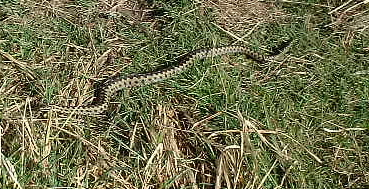
AnAdder
basked in the sun on the chalkpit lane near Lancing Ring as the sprinkling
of overnight snow gradually melted away. This is the only poisonous snake
found on mainland Britain and is also known as the Common Viper. It hibernates
during the winter.
Lancing
Nature & History - February Newsletter
The was a layer of snow
on the downs above Sompting.
Link
to a panoramic photograph by Paul Parsons (Adur Forum members only)
Lancing
Ring Photographic Gallery for February
2*
February 2001
Two
Mute
Swans landed on the A27 Flyover in the early morning fog and caused
a traffic hold-up on this busy road.
20
February 2001
A Grey
Wagtail was spotted on the shingle beach adjacent to Beach Green, Lancing.
This bird is seen occasionally every winter near water and there is a very
small breeding population in Sussex.
19
February 2001
A
flash of red tail (it could be mistaken for a red breast in flight) indicated
the male Black
Redstart flitting
between the beach huts south of Beach Green, Shoreham
Beach. It perched pipit-like on a metre-high pole sticking out of the
shingle beach where it looked black silhouetted against the morning sky.
A couple of the brownish female birds were also reported on the same day.
14
February 2001
 For
the first time for many years a good haul of the Brown
Shimp, Crangon crangon, was reported from the shallow seas
off Shoreham-by-Sea, Sussex.
Gallons of shrimps were collected in a push net at low tide. No Weevers
were netted.
For
the first time for many years a good haul of the Brown
Shimp, Crangon crangon, was reported from the shallow seas
off Shoreham-by-Sea, Sussex.
Gallons of shrimps were collected in a push net at low tide. No Weevers
were netted.
Report
by Peter Murphy
c. 14
February 2001
The first Common
Frog entered a pond in The Drive, Shoreham, and laid a large
clump of frog spawn.
12
February 2001
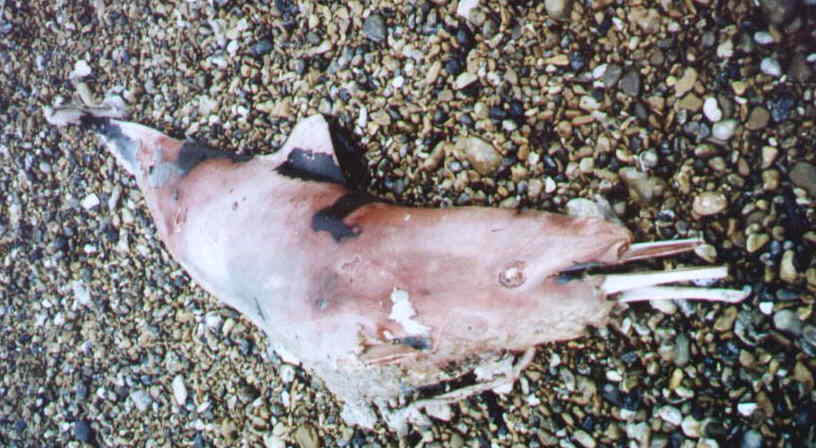
Photograph
by Steve Savage (Sea Watch Foundation)
Click
on the flipper for a close-up
Two
badly decomposed Dolphins were washed up on Shoreham
Beach, Sussex. They were badly decomposed but were probably Common
Dolphins, Delphinus delphis. A Porpoise, just over a
metre long, was washed at nearby Worthing.
Sussex
Dolphins
Sussex
Cetaceans 2001
Sussex
Sea Watch Foundation News 2001
10
February 2001
Ray
Hamblett reports a Red Admiral
Butterfly from his garden in south Lancing.
8 February
2001
After
several days of rain; the ground is saturated everywhere, especially Lancing
Ring. West
Way, Lancing was flooded, as expected up to the edge of the gardens, but
this is still not as bad as it has been in the past.
National
Floodline, Tel: 0845 988 1188

Empty egg cases of the Thornback
Ray (left) and Dogfish (right) are found washed up on the strandline by
Andy
Horton and Ray
Hamblett.
Mermaid's
Purse (BMLSS Information)
4 February
2001
Jackdaws
accompany the flocks of Crows in the Buckingham Park area of Shoreham.
There are lot of birds around, especially Robins and Blue Tits and little
brown birds in the tree tops.
 3
February 2001
3
February 2001
The
sea anemone Diadumene cincta
has been identified and photographed by Paul
Parsons off Worthing at a depth of 3 metres and they possibly occur
off Shoreham as well. It is a small sea anemone that has probably overlooked
before or incorrectly identified. The colony found was very small. It needs
to be picked out amongst the background of the Lightbulb
Sea Squirts, Clavelina lepadiformis.
Photographs
Sea
Anemones (Link)
29
January 2001
Adur
World Oceans Day 2001
The
first meeting to discuss arrangements for this Adur Festival event.
Please
express any interest to:
Andy
Horton (British Marine Life Study Society)
Glaucus@hotmail.com
or
Natalie
Brahma-Pearl (Adur District Council)
natalie.brahma-pearl@adur.gov.uk
Adur
World Oceans Day 2001 web page
21
January 2001
A
small flock (at least 6 birds) of Long-tailed Tits were seem amongst
the lower branches of the large Beech trees in the Drive, Shoreham-by-Sea,
during the steady rain that had drizzled down for the whole day. These
tiny birds (smaller than the Wren) have not seen in these trees before
(my observations in 30 years).
The
Kestrel
that
was seen almost every day in Dolphin Road for years has not be seen hovering
over the allotments or railway embankment for over six months now.
19 January
2001
The
first flurries of snow, hardly anything, are seen in the late morning.
Ice
formed on the Lancing Ring Dewpond
(Ray Hamblett)
11 January
2001
Three
Red-breasted
Mergansers settle on Widewater Lagoon. There
have been reports of up to seven. In flight they seem nearly as quick as
Mallards.


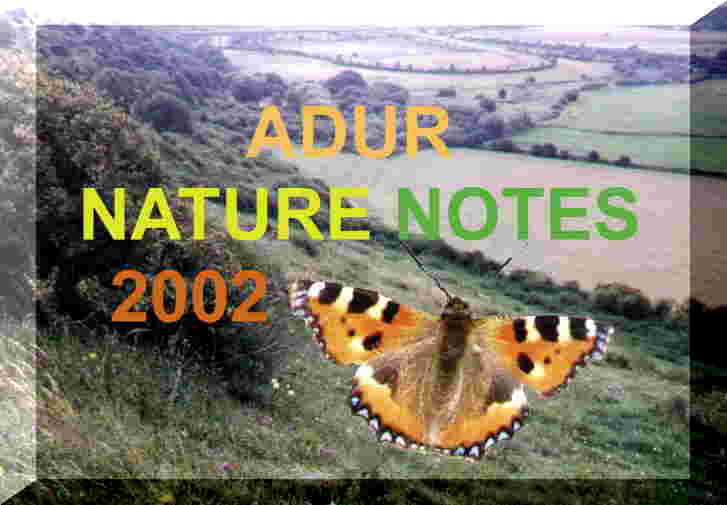



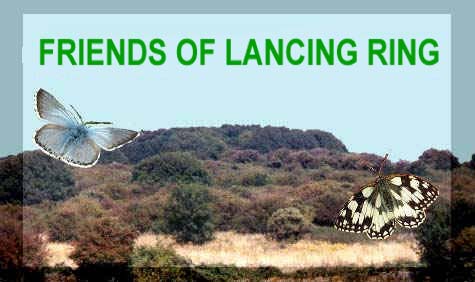





 18
September 2001
18
September 2001











 BIODIVERSITY
DISPLAY
BIODIVERSITY
DISPLAY

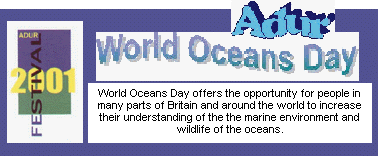








 3
February 2001
3
February 2001